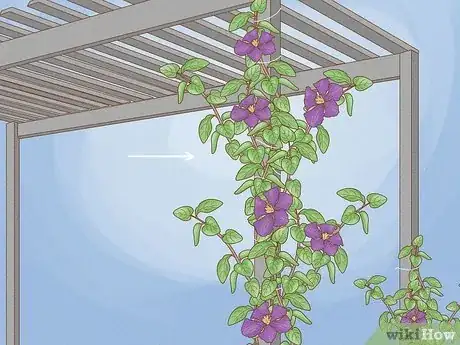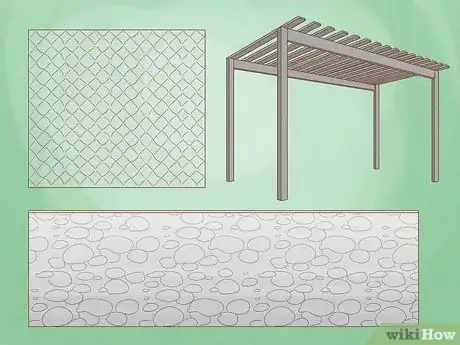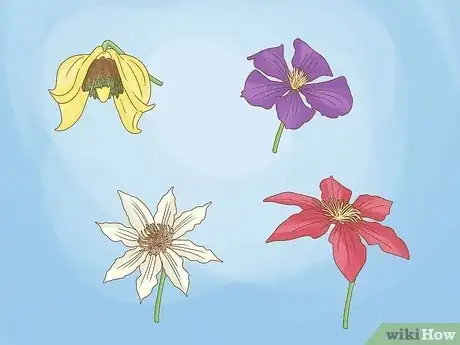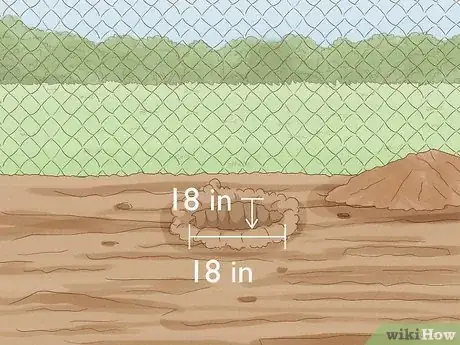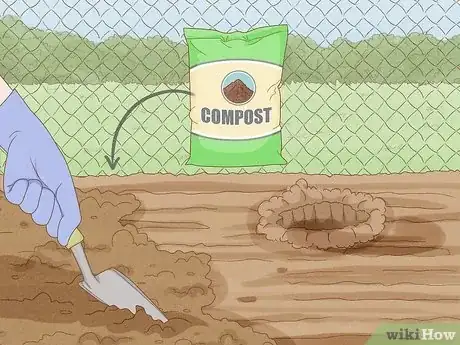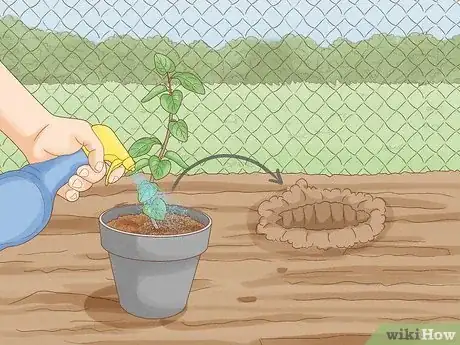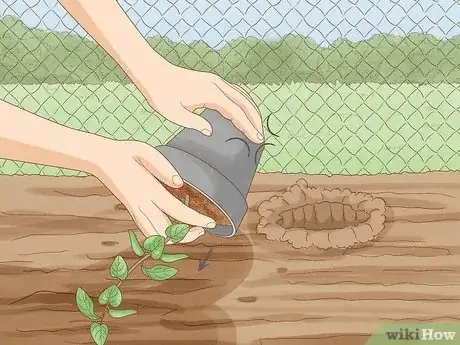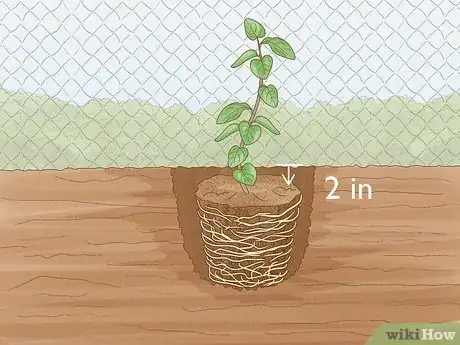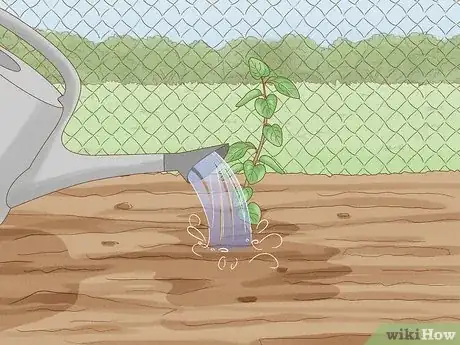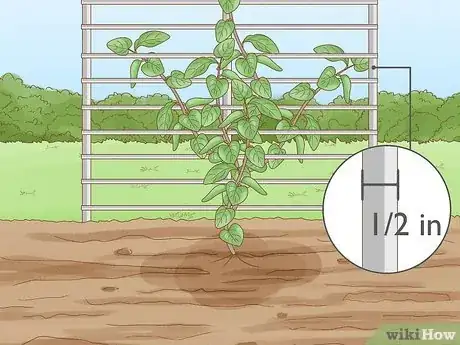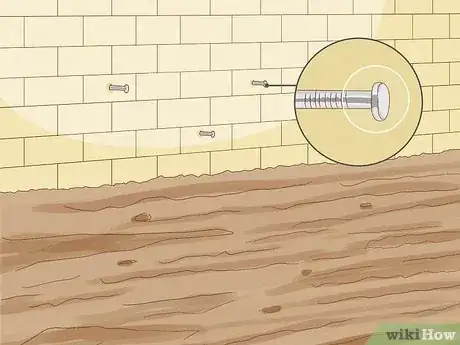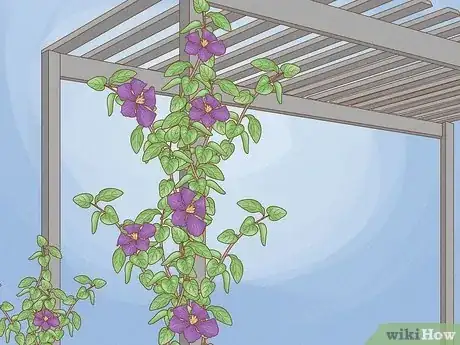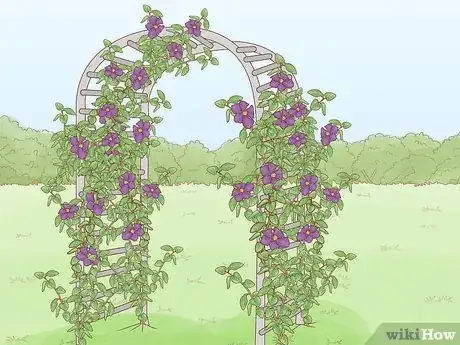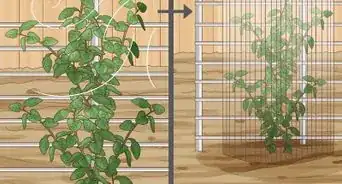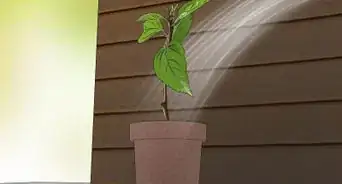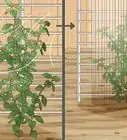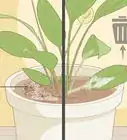This article was co-authored by Katie Gohmann. Katherine Gohmann is a Professional Gardener in Texas. She has been a home gardener and professional gardener since 2008.
This article has been viewed 60,468 times.
Clematis is a plant that can be actively trained to grow somewhere that you want it to grow. It is known as “the queen of climbers” in the garden world for its ability to add color to plain structures likes walls and fences by growing upward as a 10- to 20-foot vine. The act of growing your own clematis can seem intimidating, but with proper care and training, you can have the clematis vine of your garden dreams.
Steps
Preparing Your Garden for Clematis Plants
-
1Choose a planting location for the clematis. For optimal growth, clematis need 6 hours of sun each day so a sunny location is necessary. Keep the roots in shade and the foliage in sun - you can do this by using mulch, planting a low bush in front of it, or setting rocks on the soil around the plant.[1] As for its roots, clematis prefer well-drained, moist soil with a pH that is neutral to slightly alkaline.[2]
- Prep soil that is more on the acidic side by periodically “sweetening” it with wood ash or a little limestone.[3]
-
2Purchase building support for your clematis. Clematis are climbing plants that naturally grow upward instead of growing out like most traditional plants. In order to grow upward at its maximum height, they need support to facilitate their growth.[4]
- Bird netting offers a nearly visible means of climbing support to clematis plants. Attach it to something in your garden with a staple or a fastener to keep it stable.[5]
- Consider installing garden structures, like arbors or pergolas, which offer beauty and regality to your garden while providing support for clematis to scale.[6]
- Allow them to climb on a rock wall in your yard by planting them near there.[7]
- A trellis is also a common choice to place in gardens and is often inexpensive. Adding some netting over the trellis can make it even easier for the clematis.
Advertisement -
3Select the right clematis for your garden. If you have the room, cultivars that grow to be 10-20 feet vines might be what you're looking for. For smaller gardens or potted plants, a more compact variety of clematis might be your preference. Standard clematis flowers blossom with a measurement of 5-6 inches across.[8]
- Clematis flowers come in smaller blossoms and larger blossoms in different colors like white, wine red, lavender, deep purple, and even yellow.[9]
- Because the vine can take years to reach maturity, it is advised to purchase a clematis that is at least two years in age to shorten the wait.
- Look for a container-grown plant that's in a quart or gallon-size pot and robust in growth.[10]
Planting Clematis Plants
-
1Prepare a hole to plant the clematis. Use the pot of the plant's size to determine the size of the hole you're digging. The hole needs to be approximately 18 inches wide and 18 inches deep.[11]
- Position the hole near the center of the climbing fence or wall to give the clematis something to grow up against.
- If you notice that the ground has poor drainage, consider making a larger hole for the plant.
-
2Mix top soil from the hole with compost and a good organic fertilizer. Line the hole generously with some backfill of the mixture. Replenishing areas of the soil with fertilizer and compost moisture helps facilitate the growth of clematis by giving them cool soil to grow within.[12]
-
3Prepare the clematis for planting. As with planting any plant, watering it before the actual planting is imperative. It's especially crucial with clematis plants because they need a lot of water to grow and to keep cool. Prep it for planting by watering it deeply.
-
4Remove the clematis plant from the pot. Push up on the bottom of the pot and slide the clematis plant out sideways into your free hand. Avoid pulling on the training stake in the pot or the clematis's vine to remove it from the pot.
- If you find yourself having a hard time with sliding the plant out, roll it gently one half turn on the ground to loosen up the sides.
- Be gentle with the roots. Most of them will be at the lower half of the flower pot. If you must, tease the roots away from the sides.
-
5Examine the soil line of the plant and ground. Place the clematis in the hole, situating it at about two inches lower than the ground. It is important that the roots stay cool. Fill the remainder of the hole and the area on top of the pot's soil line with the compost, fertilizer, soil mixture.
-
6Water the clematis thoroughly. If some vines are left exposed by settling soil, cover the areas with some more of the extra soil mixture. Mulch the clematis carefully after the filling and watering of the plant is completed.
- Mulch helps soil retain moisture, which is important for clematis plants. Keep the mulch a few inches away from the base of the vines themselves.
- Water new clematis plants regularly in their first growing season so that their growth gets off to a successful start.[13]
Creating Support for Clematis Plants
-
1Be sure that the clematis will have something to climb on. Clematis plants climb by wrapping their leaf stems around the base of something. Clematis can successfully climb onto base supports made of wire, thin branches, steel rods, wooden dowels, fishing line, or twine.[14]
- Make sure that whatever surface you choose to use isn't too wide for the leaf stems to twist around. The diameter should not be more than a 1⁄2 in (1.3 cm) wide.[15]
-
2Grow clematis plants up the length of a brick wall with vine eyes. Vine eyes are large metal screws with circular endings that are driven or screwed into brickwork or masonry to create support for a wall. Wire lattice is threaded between them and pulled tightly after the vine eyes are screwed in.
- Tie the stems of the growing plant to the wire support. This can be done by incorporating metal wire, string, and paper covered twist ties.
- Check on the ties regularly to make sure that they are not too tight around the delicate growing stems. Loosen them and adjust them as needed.
-
3Display clematis in your garden by training them against screens and pergolas. Make sure that the site is not too affected by wind and rain so that a variety of different clematis plants can be grown. Prevent premature rotting in wood areas by treating the bottom of the structure on the ground with a wood preservative.
-
4Train clematis plants up along arches. For full coverage, use two clematis plants on either side to create full coverage.[16] Consider using scented clematis plants in those locations to greet passerby with sweet-smelling fragrance.
Expert Q&A
-
QuestionWhenever I touch the vine to train it towards a direction, that vine dies off. How do you train a clematis without this happening?
 Katie GohmannKatherine Gohmann is a Professional Gardener in Texas. She has been a home gardener and professional gardener since 2008.
Katie GohmannKatherine Gohmann is a Professional Gardener in Texas. She has been a home gardener and professional gardener since 2008.
Professional Gardener The vine may not be dying because you are touching it- it may have been unhealthy from the get-go. Check to make sure your plant is in good condition: Are there any yellow leaves or stems? Do you see any bugs or fungal spots on it? Are you watering too much or too little? Is the plant getting enough sun? Plants can be delicate, but can usually handle being touched. It's possible that you are being too rough with your clematis, make sure to be gentle and try to let it grow on its own, but I suspect there may be an underlying problem with the plant.
The vine may not be dying because you are touching it- it may have been unhealthy from the get-go. Check to make sure your plant is in good condition: Are there any yellow leaves or stems? Do you see any bugs or fungal spots on it? Are you watering too much or too little? Is the plant getting enough sun? Plants can be delicate, but can usually handle being touched. It's possible that you are being too rough with your clematis, make sure to be gentle and try to let it grow on its own, but I suspect there may be an underlying problem with the plant. -
QuestionDo you have to purchase a fence of is there a cheaper way to support clematis?
 Community AnswerYou can just build your own fence. It doesn't even have to be that hard. You can just put a few sticks in the ground and you're done. You can also tie a string between the sticks for some extra support. Just make sure the sticks are strong enough to not break, and dug deep enough to not fall over.
Community AnswerYou can just build your own fence. It doesn't even have to be that hard. You can just put a few sticks in the ground and you're done. You can also tie a string between the sticks for some extra support. Just make sure the sticks are strong enough to not break, and dug deep enough to not fall over. -
QuestionCan I train clematis to grow on a chain link fence?
 Community AnswerDefinitely! If one is near, it will probably grab it on its own, or you can just poke the vine through a couple of spaces and it should grow on its own from there.
Community AnswerDefinitely! If one is near, it will probably grab it on its own, or you can just poke the vine through a couple of spaces and it should grow on its own from there.
Things You'll Need
- Wire
- Wooden frame or trellis
- Ties
- Clematis plant
- Compost
- Organic fertilizer
References
- ↑ http://www.gardeners.com/how-to/grow-clematis/8203.html
- ↑ http://www.gardeners.com/how-to/grow-clematis/8203.html
- ↑ http://www.gardeners.com/how-to/grow-clematis/8203.html
- ↑ http://hummingbirdfarm.net/clematis_support.htm
- ↑ http://hummingbirdfarm.net/clematis_support.htm
- ↑ http://hummingbirdfarm.net/clematis_support.htm
- ↑ http://hummingbirdfarm.net/clematis_support.htm
- ↑ http://www.gardeners.com/how-to/grow-clematis/8203.html
- ↑ http://www.gardeners.com/how-to/grow-clematis/8203.html
- ↑ http://www.gardeners.com/how-to/grow-clematis/8203.html
- ↑ http://www.raymondevisonclematis.com/main/guidesOverAnArch.asp
- ↑ http://www.gardeners.com/how-to/grow-clematis/8203.html
- ↑ https://www.rhs.org.uk/advice/profile?PID=97
- ↑ http://www.gardeners.com/how-to/grow-clematis/8203.html
- ↑ http://www.gardeners.com/how-to/grow-clematis/8203.html
- ↑ http://www.raymondevisonclematis.com/main/guidesOverAnArch.asp
About This Article
With a little time and effort, Clematis plants can be actively trained to grow on just about any wall or fence! Clematis plants need 6 hours of sunlight a day, so you’ll want to choose a sunny location. To start, you’ll need to plant the clematis in a hole at the base of whatever climbing structure you want it to grow on and add an organic fertilizer to help it grow. Make sure to water it regularly in the first growing season, since young clematis plants need more water. As it gets taller, use vine eyes screws to tie the stems to the support or wall. Alternatively you can use wire lattice or bird netting for support. To learn how to make your own clematis supports, read more from our Gardening co-author!
